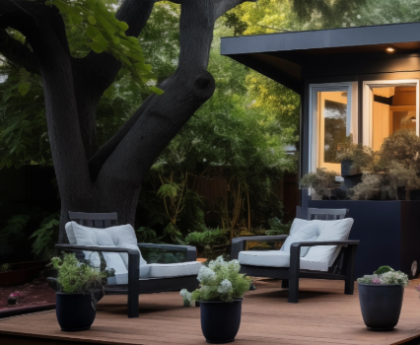
The winning ADU design by a RISD Interior Architecture team consisting of Holden Rappuhn, Vivian Wei, Alice Zhang, Mallorie Beckner, Kylee Hong, Ella Nadeau, Victoria Stotz, Xinyu Dong, Yukun Cui, and Trevor Gibson. Photo by Jaime Marland, image courtesy Rhode Island School of Design.
Students at the Rhode Island School of Design (RISD) recently collaborated with the state’s local AARP on a design-research project that was meant to demonstrate the potential of Accessory Dwelling Units (ADUs) to lawmakers currently looking at alternatives to boost housing production and care for an aging population.
The project was spearheaded by RISD faculty member Elizabeth Debs as part of the Interior Architecture department’s annual design charette challenge this past November. She says: “We look for opportunities to use design as a way to explore pressing community needs with collaborators who are experts in their fields. By working with [the] AARP, students quickly learned important strategies for aging in place as well as universal design approaches they will use throughout their careers.”
Teams were limited to a 900-square-foot footprint for their designs, which also included considerations for primary structure/site responsiveness, sustainable construction methods, and price. In the end, results were shared at a special presentation made at the state legislature in Providence in late January. (The results of the competition are available here.)
Rhode Islanders are among the fastest-aging Americans, with over 23% of the population currently 60 years old or over. Factored into this also is the state’s current status as having the lowest per-capita construction rate in the country. The ability of its existing approach to by-right approvals for ADUs to match the need for housing was recently assessed by a Harvard GSD study of the New England states. A need for more “robust” changes was among its key findings, something that the RISD presentation made clear is possible by exhibiting the latest advancements in the typology tailored to meet NIMBY stigmas and other homeowners’ concerns.
AARP Rhode Island says: “These issues can be addressed by height and size caps that require ADUs be shorter and smaller than the primary dwelling; requiring external units be behind the house and/or a minimum distance from the front curb; and imposing design standards so that external ADUs architecturally match the primary dwelling or otherwise blend with the neighborhood aesthetic.”
The presentation was instrumental in getting the Rhode Island House of Representatives to pass further legislation this week that is now waiting for approval from the state Senate with support from the Rhode Island chapter of the American Planning Association and other local entities.





